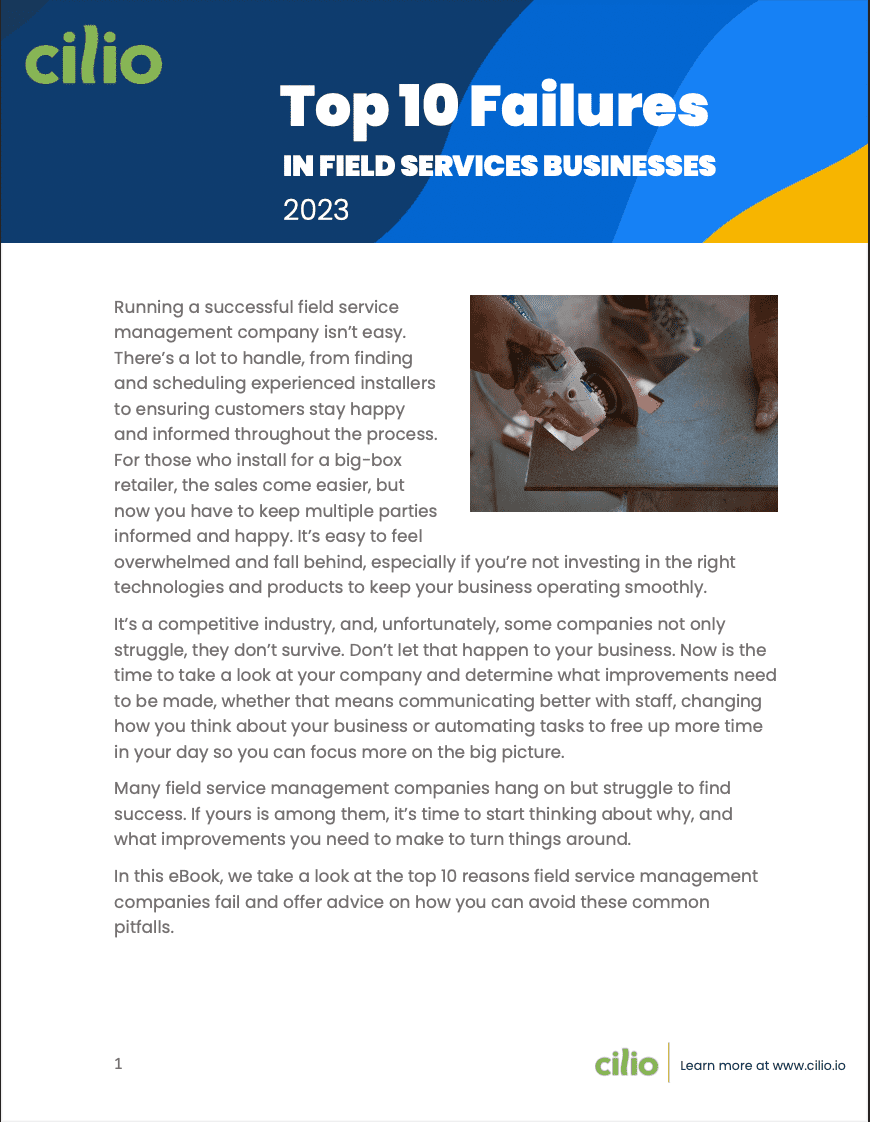Don’t miss the podcast series for more details and conversation.
A collaboration series between Cilio Technologies and Berdan Consulting.
The field service industry is a competitive one, and many companies don’t survive. In part three of this blog series we continue to discuss the top ten reasons most field service companies fail and how to survive them. This time, we focus on: 5) Understanding when to say “No” to additional customer requests, 6) The importance of embracing technology, and 7) The benefits of automating tasks.
From finding and scheduling experienced installers to interfacing with customers, there’s a lot that goes into a successful field service management business. Keeping everything running smoothly and on time is no easy task, which is why so many companies tend to struggle.
We want to help your business become a success story. Read on to learn more about why field service management companies fail, and how you can avoid three more common pitfalls.
5) Not understanding when to say “No.”
Often, clients are so happy with the work being done they ask the installer to take on tasks outside the original scope of the project. This is a great sign the customer is comfortable with your work, but there are many things to consider before saying yes or no.
The PROs of taking on additional work are tempting. You get to be the hero and save the day for the customer. You could possibly make additional revenue. You save time since you’re already there working.
However, the CONs of taking on this work can be high risk. It could impact the timeline of other scheduled work. You could take on the additional risk of underlying problems. You may end up with work outside your crew’s skillset.
Before accepting additional work, here are some important things to consider.
Consider the Cost
Will it require additional days of work or delay other clients? Should you charge for the work or not?
Consider the Impact
Will it impact your schedule or require trips to get additional materials? Does it improve the customer experience, and what is the impact of NOT doing it?
Consider the Risk
What could go wrong? Is it in the skillset of your tech, and does it require permits, tools, or materials you don’t have? Remember, once you touch it, you own it!
Either way, be sure to define the authorization process and the message. When saying Yes, charge fairly and have a written change order process with your crew to have anything additional signed off on. When saying No, avoid the wrong message. If a crewman says, “My boss said we can’t do that,” they can create a crew vs. company perception that may appear unprofessional to the client. Defining the authorization can also reduce the risk of crews doing “side-hustles” for tips that put your company reputation on the line.
The biggest takeaways here are to understand the risk and impacts of accepting additional requests, be clear with your team on who makes the call, get it in writing, and communicate!
6) Refusing to embrace technology.
This is a big one. You simply can’t be competitive if you’re working from a notebook while everyone else vying for the job has access to all the information they need from their smartphone. Today’s technologies provide so many advantages that you’ll fall too far behind if you don’t integrate them into your business.
Investing in technology like field service management software gives you instant access to every quote, project photo, and job note you’ve ever done—all from the phone in your pocket. You’ll never have to call someone back because you need to find a piece of paper and lose a project to a more high-tech contractor because of it.
Using the right software will make your team faster. When quoting work, it will help ensure your margins are protected from crews using their “gut decisions”, old versions of pricing sheets, and will help prevent them from missing key products or labor charges. Quotes can be provided right on the spot versus having to go back to the office and work up the job, thus improving your chance of closing it right away.
Many scheduling efficiencies can be found in tech. The right solution will save your crews travel time by booking work closer together, which saves fuel while squeezing more productivity out of each day. Last minute cancellations or weather delays are a part of life, but finding nearby work easily will keep your crews productive. Field techs don’t have to be “techy” to use tech. Once they see the value of getting their schedule and all job details on their mobile device, they’ll never look back.
Technology will help your team be more consistent. You might give amazing service in the slow season, but service and communication are the #1 things that decline as your business picks up. Using a software app not only makes you faster, it makes you consistent. Since every job is processed the same way, the customer experience and the communication they receive maintain your high level of quality regardless of how much your team gets squeezed in the peak season.
The bottom line is using technology has become the expectation across the board. If you don’t, you’ll lose customers and talent, and will struggle to survive.
Ready to Experience More Growth?
Running a successful field service management company isn’t easy. It’s easy to feel overwhelmed and fall behind, especially if you’re not investing in the right technologies and products to keep your business operating smoothly.
Read the Top Ten Failures In Field Services Businesses and learn how you can optimize your installation operations!

7) Not automating tasks.
With the right software, your office team can automate the more tedious parts of their workday, letting them spend that time on more impactful activities. It’s easy to automate appointment confirmations and reminders, saving your office staff the time and headaches of making phone calls and answering messages.
Automation also makes it possible for crews to see their work and job details from a single app. They can even complete job sign offs or other needed documents, saving you from keeping paper copies and chasing crews for paperwork. If you’re not automating these types of tasks, you’re wasting time. The minutes saved add up, while also making the process more consistent for your customers—improving their experience.
Through automation, you can respond to customers immediately and ask for their feedback (like Google reviews), making communication seamless. You can also use technology to understand what drives your profits and what areas need improvement; you never have to worry about losing money because of blind spots. Not only that, technology helps attract top talent to your office as well as to your installation fields. Today’s installers are used to leveraging technology and most won’t consider becoming part of a company that refuses to embrace it.
Automation frees up time for you to focus on customer-facing activities that have a better return on investment. The software can be set up to make updates, write and send invoices and even send out daily recaps on projects to show customers your progress. It all gets done in the background, allowing you to provide a higher level of service that will lead to happier clients and more jobs.
Set yourself up for growth
If you want to get ahead in this competitive industry, you have to be willing to make some changes. These tips will help you grow your business so you can experience the success you’ve always envisioned.
The teams at Bill Berdan Consulting and Cilio Technologies want to give you the tools you need to do that. For more than 20 years, Berdan Consulting has coached small customer service and provisions businesses on how to develop and implement a vision of growth, guiding them through a customized plan designed to help them meet their clients’ needs.
Cilio has developed a field service software that addresses order management challenges, helping installation service companies automate and streamline a variety of tasks to increase efficiencies and cut costs. Don’t hesitate to reach out to both companies if you have questions or need more guidance.
What to look for next time
In the final blog of this series, we’ll provide three more tips to help your business thrive. We’ll look at why you have to be willing to change to be successful, the importance of building a talented team of employees you can trust, and why it’s critical to communicate how great your experienced crew members are to clients before they show up for a job.




